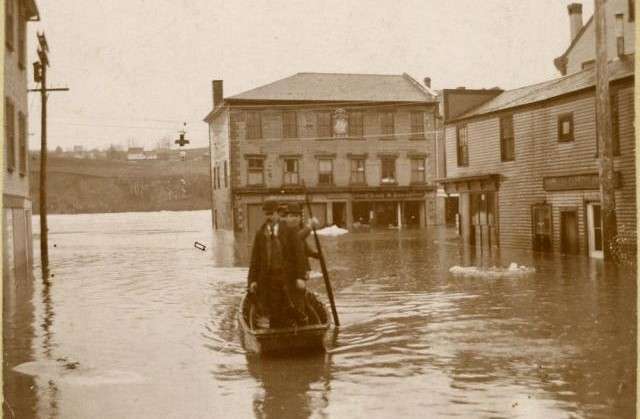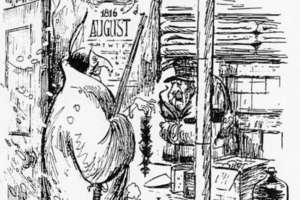Up and down the Kennebec Valley: Floods of central Maine – Part 3
by Mary Grow
And the year without a summer
Before this series moves on to describe the year without a summer, one more flood needs mention and another a description.
The Fairfield Historical Society’s bicentennial history says a March 2, 1896, freshet took out the last remaining of the three 1848 covered bridges between Fairfield and Benton, the easternmost one between Bunker Island and Benton.
Edwin Whittemore made no reference to an 1896 flood in his Waterville history, perhaps because other events that year were more significant. Discussion of a public library got serious at a February 29 public meeting and the library opened Aug. 22 (see The Town Line, Dec. 23, 2021); and another public meeting on May 18 started the process that led to the 1902 city hall and opera house building (see The Town Line, Aug. 18, 2022).
Returning to the definition of a “freshet” as a flood connected with the spring thaw, readers have no doubt noticed that freshets worth historians’ notice occurred in January, February, March, April, May, June and October. The final one to be described was in December of the year 1901 (mentioned in passing two weeks ago). Whittemore gave it a paragraph; Ernest Marriner, in his Kennebec Yesterdays, used more than two pages for his colorful account.
Marriner wrote that in 1901, there was a lot of snow after Thanksgiving. Dec. 13 (“a fateful Friday the thirteenth”) was warm enough to start melting it; a 48-hour “drenching downpour” that began Saturday evening made the Kennebec rise “suddenly and rapidly.”
The Ticonic footbridge connecting Waterville and Winslow had been in use only a few days, Whittemore said, and had already “proved itself a great convenience.” The river took it out the night of Dec. 15, Marriner wrote.
The toll house on the Waterville shore survived the night, but started downriver the next morning. It floated right side up “in a dignified manner” as far as the railroad bridge, which removed its roof and left the wreckage continuing toward Augusta.
The railroad bridge apparently stood, but there was extensive damage along the shores of the Kennebec, the Sebasticook and Messalonskee Stream (and other Maine rivers).
Marriner said the Hollingsworth and Whitney paper mill was so saturated that work couldn’t resume for two weeks. The Lockwood cotton mill shut down because the dam that diverted the river into its canal was damaged. Three hundred thousand feet of lumber washed out of the Reynolds sawmill yard in Winslow.
He mentioned a photograph of a building “near the junction of the Sebasticook and Kennebec with only the roof out of water,” and quoted the Dec. 16 Waterville Mail that said the residents of Head of Falls, the former riverside slum in Waterville, were having a worse time than usual.
Most of the tenements had two or three feet of water in the ground floors, the unnamed reporter said. One house, standing in three-foot-deep water, was roped to a tree, equally waterlogged, 25 or 30 feet up the bank.
The Dec. 16 Mail, Marriner wrote, was not the usual eight or 12 full-size pages, but four eight-and-a-half-by-11 pages of flood news. The editors apologized to the advertisers; explained that with the electric company “practically dead to the world,” staffers had converted a press to footpower; and said they hoped for, but did not promise, “a regular edition tomorrow.”
According to Marriner, the piece of low ground between Waterville’s Pleasant and Burleigh streets was, centuries ago, the bed of the Kennebec River. In December 1901, the river tried to reclaim it. Buildings flooded and intersections washed out. “Water rose far up the banks, even in the steepest sections.”
Whittemore wrote that miles of railroad track were undermined; Marriner said Waterville had no train service for three days. Roads washed out; because power plants were flooded, the electric streetcars stopped. Marriner wrote that Waterville “had no telephone connection with outside communities” for a week.
As central Kennebec Valley residents no doubt remember, there have been freshets since December 1901; your writer considers them too recent to belong in this series. And so, at last, to the Year Without a Summer.
* * * * * *
1816 was the year without a summer over most of the northern hemisphere, though the effects were especially harsh in New England, eastern Canada and parts of Europe. The main cause was a tremendous eruption of a volcano named Tambora, on what is now the Indonesian island of Sumbawa, beginning on April 5, 1815, and continuing for more than a week.
Wikipedia says the planet was then coming out of a cooler period called the Little Ice Age. There was already more dust than usual in the air from volcanic eruptions in the Caribbean and the Dutch East Indies in 1812, in Japan in 1813 and in the Philippines in 1814.
Tambora’s eruption, sources agree, was the largest and most damaging in centuries. An estimated 10,000 or more local people were killed immediately by ash heavy enough to knock down buildings, by molten lava spreading over the island and by tsunamis and other area effects.
Adding Tambora’s ash thickened atmospheric dust enough to weaken the sunlight that reached the ground, lowering the temperature world-wide. Modern estimates put the average decrease at about one degree Celsius, but parts of the British Isles, France and Spain saw an average decrease of two or three degrees.
Most of the local historians whose research has contributed so much to this series mentioned 1816. James North’s Augusta history has the most information on local effects.
North, quoting from an unnamed source, called 1816 the “coldest and ‘most disastrous [year] on record.’ Frosts occurred in every month in the year.”
An April 12 snowstorm “made sleighing for a number of days.” On May 24, “rain froze on the fruit trees then nearly ready to blossom.”
June 5 and 6 featured a northwest wind with snow and hail. “The ground froze, corn and potatoes were cut down, and workmen put on their coats and mittens. This weather continued for some days.”
North quoted from a June 8 letter that Kennebec County Sheriff Samuel Howard wrote to Henry W. Fuller, representative to the Massachusetts General Court, in Boston, saying that in Augusta it was snowing and “so cold that a large fire has been kept up in court all day.” Birds were freezing, he reported.
On July 8 and 9, North reported, “as corn was being hoed for the first time it was again cut down by a frost.”
General Henry Sewall’s diary said that Sept. 19 was a fast day, partly on account of “the decay of religion,” but also because of “the extraordinary cold and dry season.”
The same source recorded snow on Oct. 7.
North quoted Sewall’s end-of-year summary: “The year past has been remarkable – the season of vegetation was uncommonly dry and cold, not a single month without frost!” The Indian corn crop was “almost entirely cut off”; the hay crop was down by one-half; grain, especially rye, was “very considerably diminished.”
Accompanying the cold weather was a “severe drought,” leading to woods fires in the fall that caused fatalities and property loss in Maine and Canada. “In this region so severe was the drought that water is said to have been carried three miles from the river to extinguish fires,” North wrote, citing Augusta lawyer Reuel Williams.
The woodsmoke was so thick, especially when combined with morning fog, that a ferry operator got turned around and landed Williams and a visiting judge on the same side of the Kennebec they’d left, North said.
The unusual weather was accompanied by an unusual display of sunspots, especially in April, May and July. North quoted from the Portsmouth Journal: “Some of them suddenly burst forth in clusters, and appeared for a day or two and then as quickly disappeared. On the 29th of May there were six spots of magnificent proportion, varying by estimate from ten to fifteen thousand miles in diameter.”
(Most on-line sources your writer found doubt that sunspots cause short-term cooler temperatures on earth.)
North wrote that the unusual weather continued into 1817: “It was generally believed that Friday, February 14th, 1817, was ‘the coldest day ever known in this region of country.'” The cold extended as far south as Maryland and Georgia, he said.
The St. Lawrence River was frozen wide and deep, and harbors from Halifax to New York were iced-choked, except Portsmouth and Newport. There were more large sunspots.
By the spring of 1817, grain was so scarce farmers couldn’t get seed. Augusta’s May town meeting appropriated $200 for selectmen to give farmers seed, conditional on promises to plant it and to make repayment after harvest.
The plan worked; North wrote there was a good harvest in the fall of 1817. He quoted crop prices as evidence: in May in Boston, beans were $4.00 to $4.50 a bushel and corn $1.80 to 1.85, but by December, in Augusta, beans were $1.25 to 1.50 a bushel & corn $1.00.
North continued his weather record into the winter of 1819, which, he wrote, “was as remarkably warm at the north, as that of 1817 had been cold.” The high temperature in January and February was 54 degrees on Feb. 9, and there was almost no snow.
The period after the War of 1812 (which was discussed in five previous articles in this series published between February 10 and March 10, 2022) was characterized by “Ohio fever,” an emigration to the Midwest to escape the post-war economic depression and Maine winters. North wrote that Augusta was a gathering point for families heading west, to the benefit of the local economy; people bought supplies and exchanged paper money for silver “at a profitable premium.”
He repeated the estimate that Maine “lost from fifteen thousand to twenty thousand inhabitants by this exodus.” Some returned disappointed; their tales, plus warmer weather, slowed the exodus.
Ruby Crosby Wiggin, in her history of the Town of Albion, also connected the weather in 1816 and the economy.
In Albion, Wiggin said, the town saw hard economic times for several years beginning in 1810, worsened by the War of 1812. Wiggin mentioned a petition to the (Massachusetts) legislature protesting land valuations as too high; roads being discontinued; and for three years, produce allowed for tax payments if the taxpayer were short of cash.
Albion voters nonetheless voted in March 1815 to build a town house. The builder who put up and roofed the frame was to be paid partly in stock (livestock?) that a resident owed. Two later contractors finished the outside and inside, each being asked to wait until the following January for his pay.
The year without a summer contributed to the financial problem. “It would seem that residents of the town were not able to pay their taxes that year even in produce because of the scarcity of produce raised,” Wiggin commented.
She wrote that there was frost every month. One June day, children who went to school barefoot walked home in snow, unless their parents could come for them with “ox-team and sled.”
(Your writer assumed that snowy day to have been June 8 or 9, per North; but those dates were a weekend, so it must have been the beginning of the next week, when, North and other sources said, snow continued.)
Main sources
Fairfield Historical Society Fairfield, Maine 1788-1988 (1988).
Marriner, Ernest, Kennebec Yesterdays (1954).
Whittemore, Rev. Edwin Carey, Centennial History of Waterville 1802-1902 (1902).
Wiggin, Ruby Crosby, Albion on the Narrow Gauge (1964).
Websites, miscellaneous.
Responsible journalism is hard work!
It is also expensive!
If you enjoy reading The Town Line and the good news we bring you each week, would you consider a donation to help us continue the work we’re doing?
The Town Line is a 501(c)(3) nonprofit private foundation, and all donations are tax deductible under the Internal Revenue Service code.
To help, please visit our online donation page or mail a check payable to The Town Line, PO Box 89, South China, ME 04358. Your contribution is appreciated!







Leave a Reply
Want to join the discussion?Feel free to contribute!